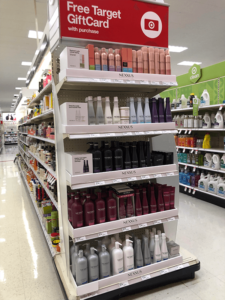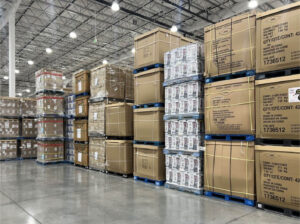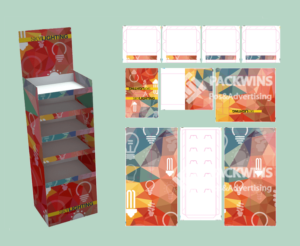Retail displays play a critical role in how shoppers discover products, compare options, and ultimately make purchase decisions. Yet many brand owners still struggle to choose the right type of display—especially when deciding between sidekick displays and endcap displays.
Both are powerful tools used by major retailers like Walmart, Target, Costco, and Sam’s Club, but they serve very different purposes. Selecting the right one can significantly impact your sell-through rate, merchandising efficiency, and even shipping costs.
In this guide, you’ll learn the key differences, best use cases, retailer requirements, cost implications, and what to provide your manufacturer so your display performs flawlessly in stores.
What Is a Sidekick Display?
Also known as a power wing display, a sidekick is a compact, lightweight display that mounts on the side of retail shelving or other fixtures. It’s designed to maximize small spaces and drive impulse purchases by placing products at natural shopper touchpoints.
Typical Features
- Hooks or shelves for lightweight goods
- Compact vertical format
- Easy to mount on a gondola, clip strip, or endcap side
- Ships flat-packed to reduce freight cost
- Ideal for small packaged items and grab-and-go products
Best for Product Categories Like:
- Snacks
- Batteries
- Beauty and personal care
- Seasonal accessories
- Toys and small electronics
- OTC supplements
Because of its small footprint, a sidekick display gives brands access to high-traffic placement without requiring large floor space.
What Is an Endcap Display?
An endcap display sits at the end of store aisles, facing major walking paths. It receives some of the highest visibility in the store, often serving as a centerpiece for promotions, seasonal campaigns, or product launches.
Typical Features
- Large panel graphics for storytelling
- High load-bearing capacity
- Structural presence for bulky or heavy SKUs
- Prominent placement that draws shopper attention
- Works as a mini in-store billboard
Best for Product Categories Like:
- Beverages
- Household goods
- Tools and hardware
- Pet supplies
- High-volume consumables
- New product launches
Research from the Path to Purchase Institute shows endcaps consistently outperform other display types due to their ability to interrupt shopper flow and attract attention.
(Reference: Path to Purchase Institute: https://p2pi.com)
Sidekick vs. Endcap: Key Differences
Below is a comparison table that summarizes the functional differences.
| Criteria | Sidekick Display | Endcap Display |
|---|---|---|
| Placement | Mounted on shelf or fixture side | End of main aisle |
| Footprint | Small | Large |
| Weight Capacity | Light to medium | Medium to heavy |
| Visibility | Medium | Very high |
| Assembly | Fast and simple | More planning and setup |
| Branding Area | Limited | Large graphic surfaces |
| Typical Use | Impulse buys, add-on selling | Promotions, seasonal, hero SKUs |
| Cost | Lower overall | Higher but stronger ROI |
| Freight Volume | Very low | Higher pallet volume |
Pros and Cons of Sidekick Displays
Advantages
✔ Cost-effective
✔ Perfect for impulse purchases
✔ Small and fits almost anywhere
✔ Minimal material usage
✔ Fast assembly for in-store merchandisers
✔ Ideal for cross-merchandising (e.g., phone accessories next to electronics aisle)
Limitations
✘ Cannot support heavy products
✘ Limited space for complex branding
✘ Requires retailer-approved hangers or brackets
✘ Lower SKU capacity
Sidekicks excel when lightweight products + low budget + impulse selling are your objectives.
Pros and Cons of Endcap Displays
Advantages
✔ Highest visibility zone in retail
✔ Large branding panels
✔ Supports promotional storytelling
✔ Accommodates heavy products
✔ Perfect for seasonal or high-traffic campaigns
✔ Can be paired with pallet displays at Costco/Sam’s Club
Limitations
✘ Higher production and shipping costs
✘ Requires retailer planning and approval
✘ Takes up significant store space
✘ Higher expectations for structural stability
Endcaps are ideal when brand impact, storytelling, and volume sell-through matter most.
When Sidekick Displays Work Best
Choose a sidekick display when:
✔ Your products are lightweight
Blister packs, sachets, small boxes, and pouches.
✔ You want impulse buy placement
Especially near checkout or category adjacency zones.
✔ You need cross-merchandising
Example: toothbrushes displayed near toothpaste.
✔ Your budget is limited
Sidekicks are extremely cost-efficient.
✔ Retailers offer limited floor space
Many convenience stores and pharmacies prefer sidekicks for this reason.
When Endcap Displays Work Best
Choose an endcap display when:
✔ You are launching a new product
Endcaps maximize visibility, making them perfect for brand introductions.
✔ Your product requires storytelling
Large graphic panels communicate value instantly.
✔ You have mid or heavy items
Drinks, cleaners, pet food, tools, etc.
✔ You’re running a seasonal promotion
Holiday, back-to-school, summer sales, etc.
✔ You need high-volume inventory in-store
Endcaps hold more stock, reducing out-of-stock risk.
Retailer Guidelines: Walmart, Target, Costco, Sam’s Club
Every major retailer has strict merchandising requirements.
Sidekick Requirements (Typical Across Retailers)
- Weight limits per hook
- Required hanger or mounting system
- Shelf alignment rules
- Maximum product overhang
- Approved board strength (E-flute, B-flute, or double-wall)
- ISTA transit test requirements
(Reference: Walmart Supplier Guidelines – https://corporate.walmart.com/suppliers)
Endcap Requirements (Typical Across Retailers)
- Exact footprint dimensions
- Required pallet height (for club stores)
- Structural reinforcement
- Drop, vibration, and compression tests
- Branding panel restrictions
- Shipper packaging requirements
- Safety and anti-tip testing
(Reference: Costco Packaging Guidelines – https://www.costco.com/packaging.html)
Your display manufacturer should proactively confirm these requirements with your category buyer.
Cost Comparison: Production & Shipping
1. Manufacturing Cost
- Sidekick: Generally low cost due to smaller size and simpler engineering.
- Endcap: Higher cost because of more materials, larger printing areas, and higher structural requirements.
2. Freight and Shipping
- Sidekick: Ships in flat packs → extremely low CBM → cost savings.
- Endcap: Larger volume, sometimes requiring pallets → higher freight cost.
3. Assembly Cost
- Sidekicks: 1–5 minutes
- Endcaps: 10–30 minutes
Retailers increasingly favor easy-to-assemble displays, so structural engineering matters more than ever.
What You Need to Provide Your Display Manufacturer
To avoid delays, rejections, or redesign fees, prepare the following information:
✔ Retailer Guidelines
Walmart, Target, Costco, and Sam’s Club have strict display requirements.
✔ Product Information
- Size
- Weight
- Packaging format
- Fragility level
✔ Display Capacity
How many units per display?
✔ Graphic Requirements
Brand guidelines, color usage, imagery, etc.
✔ Delivery Method
- KD (knockdown/disassembled)
- Pre-packed (with product already inside)
✔ Shipping Destination
Helps your producer optimize carton size and palletization.
👉 Packwins specializes in structural design optimization, helping clients reduce shipping cost by up to 30% through flat-pack designs and lightweight corrugate engineering.
Learn more: https://packwins.com
Pitfalls to Avoid When Designing Your Display
1. Choosing the Wrong Display for Product Weight
Never place heavy products on a sidekick unless engineered for load-bearing.
2. Ignoring Retailer Guidelines
Displays that don’t meet spec sheets get rejected instantly.
3. Overcomplicated Assembly
If merchandisers struggle, the display ends up unused.
4. Forgetting Shipping Considerations
CBM explosion = costly freight.
5. Poor Graphic Alignment
Misaligned art reduces brand credibility and gets flagged by retailers.
Which Display Is Best for Your Product? (Decision Framework)
Use this simple selection guide:
Choose a Sidekick If:
- Your product is lightweight
- You want impulse-buy placement
- You want lower cost
- You need fast setup
- You want cross-merchandising
Choose an Endcap If:
- Your product needs visibility
- You’re planning a promotion
- Your SKU is heavy
- You need large inventory capacity
- You want strong branding
If you want a hybrid solution, Packwins can create modular designs that allow your display to function both as a sidekick or mini-endcap depending on store requirements.
Authoritative External References Used
- Walmart Supplier Guidelines
- National Retail Federation (industry trends & shopper behavior)
These are recognized, evergreen sources widely used by retail professionals.
Conclusion
Both sidekick and endcap displays play essential roles in retail merchandising—but they serve very different purposes. Sidekicks excel at impulse buying and cost-efficient placement. Endcaps dominate in visibility, storytelling, and sales acceleration for hero SKUs.
Choosing the right display is not just a design decision—it directly impacts your sales, brand perception, and retailer acceptance.
Custom Solutions
If you need a custom sidekick, endcap, pallet display, or full POP display program, our team at Packwins can:
✔ Provide free structural design within 24 hours
✔ Create dielines based on your retailer guidelines
✔ Produce samples identical to mass production
✔ Lower your shipping cost with optimized flat-pack engineering
✔ Offer complete production + logistics support
Contact us to start your display project today.
(You can share your product size, weight, and retailer target, and we’ll recommend the best display structure.)



